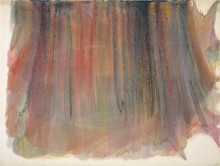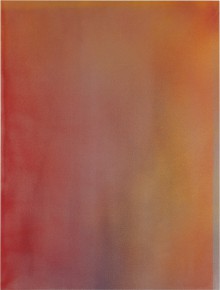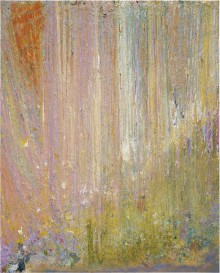Morris Louis
Number 64 1958

© 2014 Maryland College Institute of Art (MICA), Rights Administered by Artist Rights Society (ARS), New York, All Rights Reserved. Reproduction, including downloading of ARS member works is prohibited by copyright laws and international conventions without the express written permission of Artists Rights Society (ARS), New York.
Audio Description
Full Audio Transcript (Expand)
Number 64
Number 64 is an abstract painting on canvas, though it is not painted in the traditional sense of application with brushes. In 1958, Morris Louis used thinned paint poured onto an unprimed canvas so it spread and soaked creating smooth spreading fields of overlapping color with no strokes.
This image is roughly a stout trapezoid with irregular edges. Slightly narrower at the bottom than the top, the earthy hues of yellow, tan, and light blue fan out upwards to fill almost the entire ninety-two inch high by one-hundred and forty-eight inch wide canvas. The remaining negative space is very light beige.
At the center of the shape, there is a line of smudgy gray that is several inches wide that is darker at the top and thins out toward the bottom. A quarter of the way from the right side, there is another thinner line of gray that is smoother and only a few inches wide.
Three side by side blooms of blueish color spread two thirds of the way up the trapezoid from the bottom like propane flames. The almond shaped bloom at the center is the widest. Bisected by the gray line, it is dull yellow at the very bottom, surrounded by tan and then a very light lavender halo that splinters into four points at the top.
To the right of it is a slightly thinner bloom, bisected by the right gray line. This one is mostly light blue with a thin edge of blue gray, splitting into three points at the top.
On the left is a small bloom, this one is very thin, shopped more like an eiffel tower. It is a yellow glow at the very bottom surrounded by a gray lavender spike that reaches less than halfway up the trapezoid.
Four shallow bumps of brown sit side by side at the bottom edge of the canvas. The two outside bumps are slightly bigger than the two inside bumps.
On the bottom half of the left edge of the trapezoid, there is a thin sliver of bright blue peeking out from behind the rest of the earthy shades.
One can surmise that the whole canvas was folded three times like a W and then thinned paint was poured into the bottom end, accounting for the dark brown bumps, the gray lines where the canvas was folded, and the three semi-symmetrical blooms of color.







